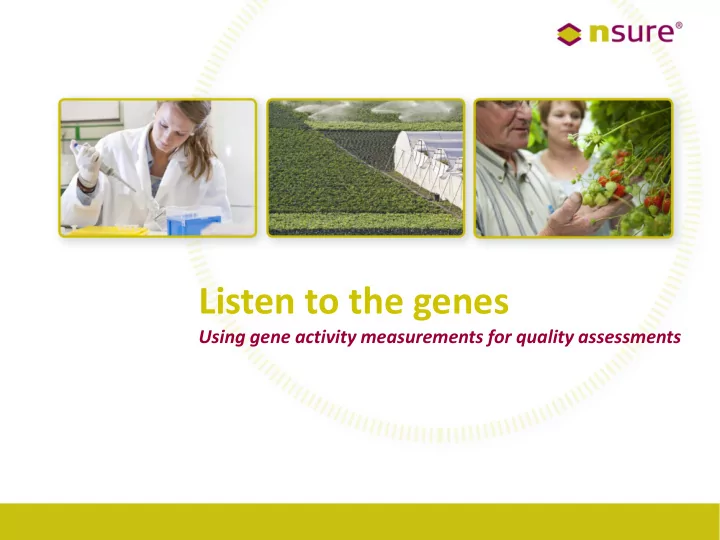

Listen to the genes Using gene activity measurements for quality assessments
Presentation Overview ▪ Introduction NSure ▪ Development of a molecular test to detect cavity spot in carrot
About NSure ▪ Established in 2006. ▪ Spin-off Wageningen University. ▪ Global leader in gene activity measurements in agricultural chain. ▪ Develop innovative and sustainable solutions to increase efficiency in every segment of the chain.
Nsure’s technology Focus on gene activity analysis • Plant senses change in conditions • Related genes switched on / off • Changing RNA content • Changing protein content • Changes in chemical composition • Effect on physiology / quality
NSure’s focus 1. Physiological switches Defining and understanding important tipping points in plant development (e.g. cold tolerance, bud break, ripening) 2. Early Warning Limiting damage during cultivation or storage through the early detection of plant responses to pathogens or stresses (e.g. carrot, tomato, strawberry) 3. BioResponse - Reaction to treatments Evidence and understanding of the effects of crop agents and biostimulants, and optimize their usage (e.g. corn, soybean, tomato, kiwifruit, grape, cherry, soybean, apple)
Applications of NSure technology Tailormade tests R&D services (development and analysis) (mode of action studies)
StoreNSure test ▪ In 2013, NSure launched the StoreNSure test for Nerac. ▪ This test determines the risk on black spot development during cold storage. ▪ It’s a generic test that measures the activity of defense related genes which are altered upon infection with one of the black spot fungi.
Development of an early warning test indicating the risk of Cavity spot in Carrot
Cavity spot ▪ Cavity spot is a major carrot disease in the UK and is mainly caused by Pythium violae. ▪ Growers try to minimise the risk by avoiding fields with a history of cavity spot and by using fungicides. ▪ Development of a diagnostic method enabling early indication of cavity spot would be of great importance in limiting economic losses. ▪ The test has to assess risk on cavity spot at two cost adding moments: before distribution of straw and before fields are covered.
Test development – cavity spot test ▪ In 2015, a project was initiated to develop a molecular test that can indicate the risk of cavity spot at an early stage. ▪ Within this project we searched for carrot genes that respond specifically upon a Pythium infection. ▪ Focus on the largest commercial variety, Nairobi. ▪ Next Generation Sequencing was used to identify potential indicator genes. ▪ Potential indicator genes were validated in various sample sets collected over two seasons (2015, 2016).
Workflow test development Next Generation Indicator Validation in various Sampling Cavity spot Sequencing selection sample sets Sept Oct all active carrot no genes no yes yes low high low high risk risk risk risk
Selection of potential indicator genes genes more active in high risk samples low risk high risk low risk high risk genes less active in high risk samples low risk high risk low risk high risk
Validation of potential indicator genes Cavity 19% ▪ The most promising indicator genes were scrutinized 23% by testing their predictive power on large sample sets collected in 2015 and 2016. 2% 22% ▪ Additional issues: 0% - incomplete sample sets and quality assessments 0% - presence of other pathogens ▪ 1% Correlation was weak. Especially in 2016. 33% low risk (high expression) 4% high risk (low expression)
Conclusions ▪ Finding cavity spot specific genes was hampered by: - Indicator identification based on samples from commercial fields turned out to be difficult - The presence of a high variety of (pathogenic) disorders that trigger comparable response mechanisms - Variability between the years
Future outlook suggestions ▪ A different approach may lead to cavity spot specific indicator genes: - Set up inoculation trial with Pythium under tight controlled conditions - Next Generation Sequencing to identify the genes that are altered upon Pythium infection - Tightly monitoring gene activity in the field over years in combination with other measures to find genuine patterns and reliable cavity spot indicator genes
Thank you for lis listening
Recommend
More recommend